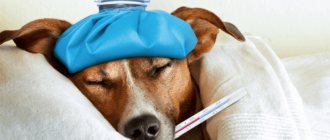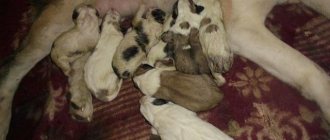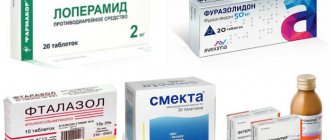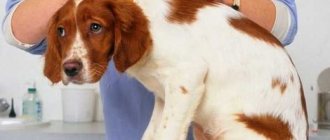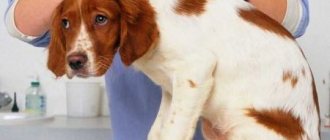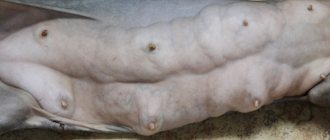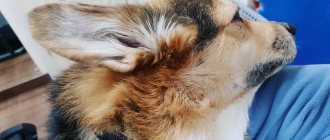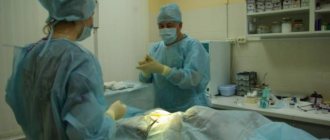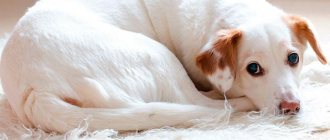Caring for a dog after sterilization on the first day
The first day after sterilization is especially important for the animal. When recovering from anesthesia, the dog may behave inappropriately, may pee under itself, or fall out of a chair or bed. For this reason, it should not be placed in elevated places. The bed must be covered with a sterile disposable diaper (sold in pharmacies) and changed regularly when it gets wet.
Sterilization operation
Important! If urinary incontinence occurs for a long time after the release of anesthesia, consultation with a veterinarian is necessary. The place for the operated dog should not be in the aisle, in a draft, or near heating devices
It is advisable to cover the bitch with something warm on top so that she does not get pneumonia, since at this time the body temperature drops and life processes slow down
The place for the operated dog should not be in a passage, in a draft, or near heating devices. It is advisable to cover the bitch with something warm on top so that she does not get pneumonia, since at this time the body temperature drops and life processes slow down.
Anesthesia after surgery usually wears off within 2-3 hours, but it will take at least a day for the dog to finally come to its senses. At this time, you should not leave the dog for a long time. Anesthesia can cause panic in an animal, a feeling of anxiety, and unreasonable aggression. This is not something to be afraid of. Everything will return to normal as soon as the anesthesia completely leaves the body. At this time, you need to stay close to your pet, create a quiet, calm environment for him, and warn your family not to disturb him.
Note! The answer to the question of how long it takes a dog to recover from anesthesia after sterilization depends on the drug administered, its dosage, and the characteristics of the animal’s body.
General rules for caring for your dog after surgery
The most important thing to remember is to always follow your veterinarian's advice. Strictly follow the recommendations of the doctor who performed your pet's surgery. In each specific case, dog care may vary, so it is possible that your pet will be prescribed, for example, a special diet. Do not doubt the doctor's words.
And if you are still not sure about the recommendations, consult not with friends or Internet users, but with another veterinarian who is able to assess the animal’s condition, its tests, and prescribed medications. There are also general rules for caring for a sick pet.
When is anesthesia used for dogs?
Anesthesia is an artificially induced, reversible condition characterized by the following symptoms:
- loss of consciousness, artificial sleep, amnesia occurs;
- the muscles relax, natural reflexes are completely or partially switched off, the dog is immobilized;
- The nerve endings do not perceive pain, and complete pain relief occurs in the animal’s body.
At the veterinarian's appointment
Indications for the use of general anesthesia for dogs:
- Carrying out abdominal operations.
- Operations on the limbs and head.
- Ear and tail docking.
- Castration.
- X-ray.
- Taking a histology analysis.
- Endoscopic examination.
- Dental treatment, cleaning tartar.
- The animal is or may be aggressive.
- Inability to fix the desired body position when the animal is conscious.
Anesthesia can be intravenous, intramuscular or inhalational. The type of anesthesia is prescribed by the doctor depending on the complexity, duration of the surgical intervention or manipulation, health status, weight, and age of the dog.
Important! Before administering anesthesia, the veterinarian examines the dog: a blood test, assessment of the condition of the heart, lungs, ultrasound of internal organs, MRI. The owner is warned about possible risks and complications
He gives written consent to the operation and other necessary manipulations.
Coming out of anesthesia: when and how?
The owner’s task is to provide the operated animal with maximum peace if he does not leave the patient in the clinic. The dog must be taken home carefully, calmly, so that there are no shaking or sudden movements. At home, the animal should be laid on a hard surface, on the floor, on its side; it is recommended to turn it over to the other side after 30 minutes to prevent muscle numbness. You should not put your dog on the sofa after surgery, because when he comes to his senses, he may accidentally fall off it. The dog should regain consciousness 3-7 hours after the operation. There is no clear answer to this question, because, for example, the body of a shepherd is different from that of a Pekingese. The speed of recovery from anesthesia is affected by age and type of anesthesia (they recover from inhalation sooner). Therefore, one dog will begin to show signs of life after 3 hours, the other after 5. That is why someone should be with the dog at all times during the day.
Most owners compare the process of a dog coming out of anesthesia with the actions of a very intoxicated person. The dog may urinate involuntarily. The owner must be prepared for this and under no circumstances scold the dog, because its muscles, including the bladder, have not yet become toned.
After surgery, a dog may twitch its paws, lie down, stand up, walk, and weave. Breathing may be slow and body temperature may be reduced. It seems that the dog is deeply unhappy, sleepy and tired. It happens less often that, coming out of the state of anesthesia, the dog is frightened, hiding, and afraid. This will pass and is normal.
The owner’s task is to provide access to fresh water, show patience, care, affection, stroke the dog, and talk to him.
The dog can recover from anesthesia within 4-8 hours. Only when everything is normal with his muscles and his gait becomes coordinated can you offer him food, and a small portion at that.
Any dog owner has the inherent desire for their beloved pet to live a long life without getting sick. Unfortunately, dogs, just like people, can become seriously ill, and treatment often requires surgery. How the rehabilitation period goes depends on the owner, so his task is to help the four-legged pet recover and regain strength as quickly as possible.
Treating a dog's stitches after surgery
To prevent the dog from licking the seams, you need to put a special blanket or Elizabethan collar on it. Postoperative sutures need to be treated with an antiseptic 1-2 times a day. It is better if it is alcohol-free, so as not to provoke additional discomfort in the animal. For example, chlorhexidine is ideal for this purpose.
After treatment with an antiseptic, it is necessary to carefully lubricate the seams with antimicrobial and healing ointment. The drug levomekol has proven itself very well. You can find these simple and inexpensive medicines in any human pharmacy.
If the animal is prescribed any medications, they must be given strictly according to the instructions. If the schedule is not followed, treatment may not be effective and you will have to repeat it. Any deviations from the recommendations must be agreed with your doctor.
Don’t hesitate to ask again and clarify: you are not a doctor, you are worried about your animal and may not figure it out the first time. The veterinarian must explain his instructions so that you can follow them.
A place for the dog to rest during the postoperative period
- Provide the animal with the most comfortable conditions for recovery. Make sure that the place where the dog rests is dry, comfortable, warm, but not hot, and always without drafts.
- If the house is cool, cover your pet with a blanket to prevent him from getting too cold. To prevent your pet from falling, do not arrange a bed for him on a hill.
- Please note: when recovering from anesthesia, the animal will move awkwardly and its limbs will be sluggish, so make sure that it does not climb onto the sofa or chair. In this case, falling even from such a low object can be dangerous.
- If the dog experiences involuntary urination or any profuse urination after surgery, lay down a waterproof oilcloth and well-absorbent diapers. Don't worry: this is normal after anesthesia. And, of course, do not scold your pet for its ego.
- In the first 3-4 weeks, constantly monitor the animal’s health. Inspect your pet's lips and gums daily. If their color has changed (become bluish or white), take your pet to the vet as soon as possible.
- Also make sure that there is no blood in the animal’s excrement. Intense bleeding from the surgical wound, an inflamed appearance of the suture, or an unpleasant odor from the wound are also signs that the dog is not recovering.
Be attentive to your four-legged friend, take good care of him, give him affection and care - and the dog will thank you with his devotion and sincere kindness.
About dog sterilization
It is recommended to perform the operation before the first heat at the age of six to seven months, this reduces the risk of developing mammary tumors in the future. But in general there are no age restrictions. You need to focus on existing or absent diseases. Read a detailed article on the topic: “Dog sterilization – features, types and nuances of the procedure.”
There are different methods of sterilization:
- Through the white line. Classic way. The incision is made just below the navel.
- Lateral access. In this case, the surgical field will be located on the side. This approach is most often used in large and giant breed bitches to minimize the risk of postoperative hernia.
- Laparoscopic sterilization. It is carried out using a special device - an endoscope. Minimal invasiveness. The operation is performed through 2-3 punctures on the abdominal wall. But such sterilization costs about twice as much as classical sterilization.
- Removal of only the ovaries. Some surgeons leave the uterus and remove only the ovaries to minimize surgical access in young female dogs without pathologies.
- Removal of the uterus and ovaries. More often, to avoid problems, complete resection of the internal genital organs is recommended.
Which method to choose depends on the wishes of the owner and the recommendations of the surgeon. Be sure to discuss this issue before surgery. It is also worth asking your doctor whether additional diagnostics are needed in the form of blood tests and ultrasound of the heart to find out the degree of anesthetic risk, since the operation is performed under general anesthesia.
Prevention
To prevent hypothermia in a dog living on the street, insulate its kennel. It should not be blown by the wind or get wet. Place hay or straw in the kennel to keep your dog warm. Do not use blankets or old jackets for these purposes; they quickly become wet and covered with ice. Frozen things will not only not warm the dog, but on the contrary will cool its body.
Walking with a pet living in an apartment should be done actively during the cold season. It is better if they are not very long. Animals of hairless or short-haired breeds should be dressed in warm overalls .
To prevent paws from freezing, you can purchase boots or special protective dog socks. Do not use human fatty creams for these purposes, they will only worsen the situation.
In winter, the calorie intake increases. This is especially important for young and active pets. Monitor your dog's condition, as exhausted animals freeze much faster.
If hypothermia cannot be avoided, immediately take your pet to a veterinary clinic.
A healthy dog's body temperature ranges from 38 to 39 degrees Celsius. Small deviations are possible, both positive and negative. If it begins to fall significantly below the permissible values, then you need to urgently take your pet to the clinic.
Unfortunately, in this situation, without examination, the exact cause of this condition cannot be established. See a good specialist...You may also need to take blood tests and perform an ultrasound examination of the abdominal cavity and take an x-ray.
There can be many reasons for this condition, and without additional research and examination it is impossible to say anything specific. I advise you to see a good specialist and perform a full examination!
Judging by what was described above, the doctors who treated the dog know their stuff. Contact them, you can place the dog in a hospital for treatment. Maybe she attracts your attention by squealing. But she definitely needs intravenous drips and repeated tests. Parenteral nutrition can be performed!
Only registered users have the ability to start new topics. Register and log in to the site by entering your username and password on the right side of the window, and you can start a new topic.
Before visiting the forum, read the topic: “How to properly consult a veterinarian,” as well as the list of answers to frequently asked questions, this will help you save your time and get an answer to your question faster. Pay special attention to the document: Symptoms of animal diseases. Perhaps in your situation you cannot expect an answer on the forum, but you need to urgently call a doctor or take the animal to a veterinary clinic!
We recommend reading: Cats lose weight after castration
Before joining the forum, read the following sections, this will help save your time and quickly get an answer to your question:
Attention! Pay special attention to the document “Symptoms of Animal Diseases”. Perhaps in your situation you cannot expect an answer on the forum, but you need to urgently call a doctor or take the animal to a veterinary clinic!
There can be many reasons for this condition, and without additional research and examination it is impossible to say anything specific. I advise you to see a good specialist and perform a full examination!
Low temperature in a dog (hypothermia) is a condition when the animal's temperature drops lower than necessary to support normal body function and metabolism.
The alarm should be sounded if the dog's body temperature is below 37.5
There are three degrees of hypothermia:
1) Lightweight. The indicators drop to 32 degrees. This condition is characterized by drowsiness, trembling of the limbs, weakness and depression.
2) Moderate. Indicators drop to 28 degrees. In this condition, there is a decrease in heart rate (pulse), muscle weakness, stupor, and arterial hypotension.
3) Deep. Indicators drop below 28 degrees. In this condition, there is a disruption in the functioning of the cardiovascular and respiratory systems, the pupils dilate, and the dog may fall into a coma.
Reasons for the drop in temperature
The main causes of low temperature in a dog:
• hypothermia • impaired thermoregulation in puppies and older dogs • surgery on the abdominal or chest organs for more than 1.5-2 hours • duration of anesthesia for more than 4 hours • diseases of the thyroid gland (hypothyroidism) or adrenal glands • head injuries • diseases of the cardiovascular system • diseases of the nervous system • and other causes
How to determine low temperature?
Any deviation from the norm causes a change in behavior and reactions. Therefore, you can notice a low temperature in a dog quite quickly.
First of all, the animal curls up into a ball and tries to find a warm place. Muscle tremors appear, due to which the body produces additional heat. The fur may become ruffled to increase the air gap between the skin and the external environment.
Moreover, the blood vessels on the surface of the skin constrict to reduce heat loss. As a result, visible areas of the skin and mucous membranes are pale and cool. Frequency and depth of breathing
If your dog shows all of the above symptoms and the temperature is below normal, then the next step to diagnose hypothermia will be a mandatory blood test. In this case, a decrease in platelet levels and increased blood viscosity are almost always detected. The reason is the narrowing of peripheral vessels and the accumulation of blood in the veins. And this, in turn, is fraught with the development of arrhythmia and arterial hypotension.
How to provide first aid?
Let's figure out what to do if your dog has a low temperature.
If the dog's temperature has dropped as a result of hypothermia, then first aid is as follows: • urgently place the dog in a warm room • carefully wrap it in a warm blanket or any woolen items • cover it with heating pads or plastic bottles with warm water (temperature 38-40 degrees). Note! The water cools down quickly! • give warm water to drink (if the animal refuses, slowly give it a tablespoon on the cheek or use a syringe WITHOUT A NEEDLE) • control the temperature every 10-15 minutes
This is where helping a dog with a low temperature at home ends.
Next, the dog urgently needs veterinary help
The fact is that if the temperature has surpassed 36 degrees and continued to decline, heat loss increases catastrophically. At the same time, trembling in the body disappears, the pulse may be weak or absent, breathing is shallow and rare, and the heart rate is reduced.
We recommend reading: Allergies in Cats From Dry Food Photo
Therefore, active warming, as well as establishing the causes of a decrease in temperature, is possible only in a hospital setting under the supervision of a doctor. Dot.
The dog should be taken to the clinic immediately! Of course, wrapped in the warmest blanket and placed hot water bottles with warm water on your body.
Treatment
The extent of treatment needed to treat a dog with a low temperature will depend on the cause and severity of the illness.
The main task of the veterinarian is to increase body temperature and prevent the development of severe anemia, which can lead to further cooling and cardiac arrest.
1) Mild hypothermia. A wool blanket and warm heating pads are enough to keep you warm.
2) Moderate hypothermia. Warming pads and an electric heater will be required. Important! First of all, the body is warmed, not the paws. This is necessary to stop heat loss due to vasodilation in the periphery.
3) Deep hypothermia. In this situation, intensive therapy will be required to eliminate disturbances in the functioning of the affected organs and systems. Breathing support is also essential. blood circulation and warming of internal organs. One of the methods of warming is enemas with warm water and intravenous infusions of heated solutions. In case of respiratory arrest, resuscitation measures will be carried out.
In parallel with providing assistance, it is necessary to identify and eliminate the causes of the dog’s low temperature. To do this, you need to take a blood test, measure your blood pressure and do an electrocardiogram.
Whatever one may say, the result of treatment for hypothermia directly depends on its cause, the severity of the dog’s condition and the time until professional help is provided.
Note! In case of hypothermia, even very long, lasting several hours, resuscitation measures can be SUCCESSFUL! The death of an animal can only be confirmed when it is warmed to a temperature of 30-32 degrees.
But, unfortunately, the result of long-term resuscitation is not always favorable. Serious disorders are possible, both as a result of deep hypothermia and prolonged resuscitation.
It must be said that in older animals that have suffered hypothermia, residual brain damage may persist. As a result, they are vulnerable to repeated hypothermia and require special care and warmth.
Dog after anesthesia
After the operation, the dog needs maximum rest as it recovers from anesthesia. Quite often in this regard you can hear the question: how long does it take for a dog to recover from anesthesia? Under such circumstances, the purely individual characteristics of the body come into play. There are dogs that manage to recover from the state of anesthesia in a few hours, while others need the whole day. When recovering from anesthesia, the dog may experience complications:
- Waking up after surgery is delayed.
- The animal may vomit.
- The dog is trembling after anesthesia.
- Your pet's breathing becomes slower.
- Your pet's heart rate may weaken.
- The dog begins to breathe rapidly and wheeze. Such a danger may arise if the animal has problems with the cardiovascular or respiratory system, or there is some kind of pathology.
- Possibly a drop in temperature.
- Allergic irritation on the stomach is possible.
- The dog is shaking after anesthesia.
- There may be problems with the toilet (constipation, urine does not flow on its own).
The owner should know that the dog needs to wet his lips and tongue with water in cases where the pet is not able to quickly recover from anesthesia. It is necessary to place water next to the place where the operated animal lies. You can start giving your dog water five to seven hours after it comes out of the anesthesia state. But with feeding, you should wait. Food can only be offered to her after ten to twelve hours.
At a later stage, postoperative stroke or pulmonary edema may occur. This development can occur in weakened animals or animals that have prerequisites for these diseases. High-quality and timely diagnosis by a doctor can reduce unwanted consequences for your pet to a minimum. For advice, contact your veterinarian. At the same time, carefully weigh the pros and cons before you agree to administer anesthesia to dogs, unless this is an urgent life necessity.
Anesthesia is used quite often in veterinary practice and not only during operations. Being in a state of excitement, the dog may behave aggressively with the doctor or owner and refuse to follow his commands. To eliminate this behavior during various medical procedures, general anesthesia is used.
Dog's temperature
Body temperature is one of the main indicators of the state of the body, not only of the human body, but also of our smaller brothers.
We recommend reading: Distemper in Cats Duration of the Disease
A loving owner needs to know that a dog’s normal temperature should be from 38° to 39.3°C. But not everything is so simple, and indicators may vary. For example, the temperature of a small breed puppy will be slightly higher (38.6⁰-39.3⁰) than the temperature of a large breed puppy (38.2⁰-39.0⁰), adult dogs of small breeds have a higher temperature (38.5⁰-39.0⁰) than adult dogs of large breeds (37.4⁰-38.3⁰). Temperature changes, in some cases, may depend on individual characteristics, the sexual cycle, and physiological state. There is no need to worry if your dog's body temperature is slightly elevated in a stressful situation - after a visit to the veterinary clinic or after giving birth.
But it should be remembered that the increase should not be more than 1 degree Celsius. If you deviate from this norm, take a closer look at your pet. Urgent medical care is needed if the temperature is above 41°C - such a high temperature in a dog is dangerous for its life.
Symptoms of fever in a dog
Contrary to popular belief, a dry, wet nose is not an indicator of body temperature. The main symptoms of fever in a dog:
- lethargy;
- lack or decreased appetite;
- increased thirst;
- shiver;
- vomit.
How to measure a dog's temperature?
To know what your dog's normal temperature is, you need to measure it periodically. The dog may not like this manipulation for the first time, but then it will get used to it. Even if you don't do this regularly, if you suspect a temperature, take it before visiting your veterinarian. Most likely, the dog will place more trust in you, its owner, and will endure this procedure in a calm, homely environment with less worry. Every owner should know how to measure a dog's temperature. Temperature is measured rectally. This can be done with a special rectal thermometer, but a regular mercury or electronic thermometer will do just fine. First, prepare the thermometer: reset the readings to zero, lubricate the tip of the thermometer with cream. An electronic thermometer is more convenient - the dog will have to wait only 1 minute, a little more time - measuring the temperature with a mercury thermometer will take 2-3 minutes. Don’t forget to speak kindly to your dog during the procedure, and then treat him to something tasty.
What to do if your dog has a fever?
What should you do if your dog does develop a fever:
- Don't knock it down. Before lowering your dog's temperature, you must first find out what caused this increase. High fever in dogs can be caused by infections, toxins, or vaccinations.
- Contact your veterinarian.
- Wet your dog's fur with cold water or point a fan at him. But such actions should be stopped as soon as the dog’s body temperature drops to 39.5 °C.
- Giving your dog as much water as possible will help prevent dehydration.
- Give medications as prescribed by your doctor.
Low temperature in a dog
A low temperature in a dog is also considered a deviation from the norm. This can happen, for example, after surgery, in which case you need to cover her warmly and be sure to consult a veterinarian. The body temperature of a pregnant dog can also change; before giving birth it drops by one degree compared to the norm (up to 37-37.5 ° C). The normal body temperature of a newborn puppy on the first day is also slightly lower than usual - 33-36 °C, about 15-20 days it will be about 36.5-38 °C. During this period, it is advisable to provide the puppy with optimal conditions. Even short-term hypothermia can lead to a worsening of his condition.
What should you do if your dog does develop a fever:
Types of post-traumatic stress for dog recovery.
The first thing to remember is that the dog’s complete return to normal life and good condition will occur +- after 3 months
such restoration. You need to have patience and do everything very slowly and gradually. In addition, as I wrote above, if there is any deterioration, stop doing what you were doing.
And I think it doesn’t require a reminder that:
Walking leisurely walks with the dog.
Also, I want to clarify, since I always hear this question from patients: we do not pay attention to exactly how the dog walks, if it is a walk or a trot. We estimate the pace of movement by your step. Naturally, if I say you walk at your slow pace, then you will need to match the tempo of your step to your breed. If you, having a Great Dane or a Wolfhound, can barely crawl, then the dog simply will not be able to walk at all, in this case, of course, you will have to walk not at a very slow pace, but in such a way that the dog can move smoothly, but very slowly, at a pace next to you. If you have a Spitz, then you will need to walk very, very slowly, let’s say practically crawl, so that the dog walks at a slow pace.
Swimming for dogs.
Swimming in a pool or in a pond (if it’s summer) is allowed in any quantity (but if it’s a pond and if it’s cool, the dog needs to be thoroughly dried and taken home), and when I say swimming, I mean swimming, not splashing around in the water or diving.
Is running necessary?
Treadmills. It's better to wait. Because treadmills, as I described in one of the articles, have 2 sides of the coin.
Also, please remember that for a dog such a load, which is described below, is very large (yes, I know, there is an opinion that the best and sufficient load for a dog is walking without a leash, but this is a myth, a dangerous myth!), so don’t worry, if your dog, after what you think are small walks, sleeps like the dead or seems very tired. This is fine!
Bouillon
If the dog has no appetite, you need to give the dog broth once or twice to stimulate it. Meat broth should be a mandatory dish in a dog’s diet after surgery, as it is very nutritious and good for the stomach . By activating digestion, the broth will prepare the animal’s gastrointestinal tract for the consumption of more substantial food.
It is better to cook the broth from chicken or beef ; veal is perfect. To make the broth healthy and rich, after boiling the meat must be simmered over low heat in a small amount of water for at least an hour.
Why does constipation occur after surgery?
Quite often, after surgery, dogs develop constipation. The main reason is the use of drugs that put the dog under anesthesia, maintain medicated sleep and are used for pain relief after the intervention.
The development of constipation is facilitated by the stress that the dog received on the way to the clinic and after waking up. Feeling vulnerable, the dog may deliberately suppress the urge to defecate so as not to attract unnecessary attention to itself with the smell. Quite often, animals hold back the urge to defecate after sterilization because their incision hurts.
Immediately after surgery, the dog may not have bowel movements because there is nothing in it. Before administering anesthesia, veterinarians recommend following a fasting diet for 3-6 hours. Usually, on the first day after surgery, the dog refuses to eat, but drinks water.
Some procedures are not performed under deep anesthesia, but with the use of sedatives. For example, when opening abscesses, local anesthesia is used. After such interventions, the dog may develop constipation due to stress and temporary intestinal atony.
Drugs used to immobilize animals affect intestinal contractility and muscle tone. After immobilizing drugs, the dog comes to its senses within 1–3 days
At the same time, it is important to help the animal’s body by taking the pet for short but frequent walks.
After surgery, dogs often develop dehydration and electrolyte imbalance. These changes in the dog’s body are expressed by constipation or other digestive disorders. During surgery, the animal loses fluid, but veterinarians usually restore the balance using buffer solutions.
Dehydration is further aggravated by the fact that after anesthesia the dog can sleep for 10–12 hours. If your pet sleeps long and soundly after surgery, he does not need to be awakened to feed. To alleviate the condition and eliminate dryness in the mouth, it is necessary to moisten the tongue with clean water.
After the animal recovers from anesthesia, it will begin to be interested in food. To restore electrolyte metabolism as quickly as possible, the animal needs to be offered liquid food. For dogs kept on a natural diet, low-fat broths and fermented milk products are suitable. If your pet is accustomed to commercial food, he should be offered canned food diluted with water.
Recovery time for a dog after surgery
Typically, the rehabilitation period after surgery lasts about 10-14 days. Only after the most complex surgical intervention, special care for the animal can last up to two months. This primarily applies to older dogs, in which the recovery of the body occurs much more slowly, and complications may arise.
Some inexperienced owners remember the well-known saying “it will heal like a dog” and think that a couple of days after a complex procedure their pet will be able to easily overcome high barriers and run in the morning just like before. But you shouldn't count on it.
Even if your pet looks completely healthy, do not rush to return him to his usual and comfortable lifestyle, as this can lead to complications. If the doctor prescribed two weeks of “bed rest,” it means that these recommendations must be strictly adhered to, even if you feel so “uncomfortable” and it seems that your pet is “still a big guy.”
Rehabilitation period
To prevent the development of a bacterial infection, injections of antibiotics are prescribed from the first day after surgery: Oxacillin, Amoxicillin, Ceftriaxone or Cefazolin. The standard course of antibiotic therapy is 5-7 days. If the dog is in pain, whines, avoids sudden movements, or tries to reach the scar, it is worth giving it analgesics for several days, since severe pain can slow down the healing process.
The stitches are treated with an antiseptic (chlorhexine or hydrogen peroxide) for at least a week, 2 times a day; it is strictly forbidden to wet the wound. To care for the seam you can also use:
- Levomekol ointment (apply it 1-2 times a day, covering it with a gauze cloth);
- Terramycin spray (suture treatment is carried out every 3 days);
- Aluminum spray (a product that forms a thin film that prevents contamination of the seam; it must be applied once a day).
The stitches are removed after 1.5 - 2 weeks. Most modern veterinary clinics use absorbable suture material during surgery; such sutures do not need to be removed. To prevent the dog from licking and scratching the wound, they put on an apron blanket (you need to have several of these blankets in order to change them as they become dirty). If necessary, you can purchase a special hard collar in the shape of a funnel - it will deprive the animal of the opportunity to reach the itchy seam with its teeth.
You can start feeding your pet one day after surgery. Food should be given in small portions, the food in the first few days should be soft and easily digestible: pates, minced meat, baby formula. Retention of stool for up to 3 days does not pose a danger, since the animal’s stomach was empty before sterilization, and intestinal motility after anesthesia is slow. If the dog does not recover for more than 3 days, he can be given one or two tablespoons of Vaseline oil.
Helpful information. Rehabilitation of a dog after sterilization takes about 2 weeks. In the future, it is advisable to switch her to a low-calorie diet, since sterilized animals are often prone to gaining excess weight.
Lines of ready-made food intended for castrated and sterilized animals are produced by Products Limited, Agras Delic, Purina, Bosch Tiernahrung. If you prepare food for your animal at home, it is advisable to choose lean meats and add fiber-rich vegetables to it.
Veterinarian video tips
about postoperative care:
- Dog sterilization
- Cowinan for dogs
- Endometritis in a dog: symptoms and treatment
Feeding the dog after surgery
Follow the feeding recommendations your veterinarian gives you. Even if the new dog “diet” is too troublesome for you, be patient at least for the rehabilitation period. Your care will allow the dog to recover faster.
The diet may vary depending on the type of surgery. But there are also general rules. The dog should not be fed or watered for several hours after surgery. This is especially important if the surgical intervention was in the abdominal cavity or the animal has undergone complex anesthesia.
Then you need to give food in very small portions and often (3-4 times a day). In addition, food should be fresh, light and preferably liquid.
If you give your pet dry food, soak it in warm water so that he doesn't have to chew and also to ease the digestion process.
If this does not contradict the veterinarian's recommendations, you can use special canned food, but it is better if they are dietary. Foods that are unfamiliar to the dog should not be given. Many animals already have no appetite after surgery, so they are unlikely to want to try new food.
If you usually feed your pet natural food, give him broth for the first post-operative meal, and then feed him porridge with minced meat, cottage cheese, and kefir. Unless, of course, the veterinarian gave other recommendations.
In addition, the dog should always have access to clean drinking water. However, in the first days after surgery, it is better to slightly limit the amount of fluid consumed. And do not forget to regularly change the water to fresh water. If the animal cannot stand up on its own, carefully feed it from a syringe without a needle, because a dehydrated body will not be able to regain its strength.
Return your dog to its usual diet gradually: over the course of a week, add a little regular food to the medicinal food. And with each feeding, increase the portion of your usual food.
Attention! If your dog has any digestive problems, consult your doctor. Under no circumstances should you give your animal any medications without your veterinarian’s knowledge, as they may not be compatible with the medications you are using to restore your pet’s health. Don’t be lazy and consult a veterinarian once again, even if you think that you might have imagined the alarming symptoms. It’s better to be safe than to not notice the deterioration.
Materials and methods
Between 1978 and 1989, 132 dogs and 51 cats underwent OGBC surgery. This procedure was used in cases where joint preservation was not feasible or practical (Fig. 1). The most common indication in dogs was avascular necrosis of the femoral head due to Legg-Calvé-Perthes disease; most animals suffering from this disease weighed
In all cases, a craniolateral approach to the hip joint was used. After bending the joint capsule and cutting the round ligament, the limb was rotated 90° outward. An osteotome or vibrating saw was used to perform osteotomy of the femoral head. Sometimes the lesser trochanter was also cut off. To completely remove the caudal edge of the femoral neck, the osteotome or saw was held perpendicular to the long axis of the femoral neck (Fig. 3). The goal of this intervention was to create a smooth resection plane without bony protrusions. In most cases, the joint capsule was closed to create a layer of tissue between the acetabulum and the cutting surface of the femur after removal of the head and neck (Fig. 4) (17). Toward the end of the study, some animals received two additional sutures of durable, slowly absorbable material to secure the gluteal tendons to the insertion of the rectus femoris muscle to prevent caudodorsal displacement of the femur. The wound was sutured in the usual manner. Immediately after surgery, photographs were taken in the ventrodorsal projection to determine the osteotomy plane.
Follow-up examinations of 81 animals (66 dogs and 15 cats) were carried out 7 months to 10 years after surgery (average 4 years) in our clinic.
Rice. 1. Indications for osteotomy of the femoral head and neck in 132 dogs and 51 cats.
Rice. 2. Weight distribution of 132 dogs and 51 cats who underwent osteotomy of the femoral head and neck (the weight of 5 dogs is unknown).
Rice. 3. Orientation of the osteotome during femoral neck osteotomy.
Rice. 4. The joint capsule was positioned between the osteotomy site and the acetabulum to avoid pain due to contact of the two bony surfaces.
a) view of the hip joint in the transverse plane before resection;
b) view after removal of the head and neck of the femur;
c) closing the joint capsule;
d) ventral view of the acetabulum after closure of the joint capsule.
Clinical parameters assessed included lameness, muscle atrophy, pain with passive movement, crepitus, caudodorsal displacement of the femur, and range of motion. These objective variables were supplemented by the owners' assessment of the following indicators:
- duration of postoperative symptoms;
- duration of the postoperative recovery period;
- leaning on the affected limb during slow gait, fast gait, after strenuous physical activity and in cold or damp weather;
- subjective assessment of the success of surgical intervention.
Scores were assigned as follows:
- good: no lameness, the animal fully relies on the limb at all gaits;
- satisfactory: slight lameness, sometimes stiffness, sometimes lameness without support of the limb;
- unsatisfactory: mild to severe persistent lameness, the animal often does not support the limb, lameness after exercise, lameness when trotting and/or galloping, lameness associated with weather.
In 67 cases (55 dogs and 12 cats), radiographs were taken immediately after surgery to assess the completeness of resection of the femoral neck with or without removal of the lesser trochanter and to ensure that there were no sharp bone edges along the osteotomy line. 17 dogs were also studied in a movement assessment laboratory (18, 19). Using a treadmill with four built-in load plates, the following kinetic parameters were assessed:
- duration of the support phase (ms);
- peak vertical support load (% of body weight);
- slope of the support load curve (% of body weight/sec);
- integral (% of body weight x sec).
Kinematic data were obtained using reflective markers placed on the iliac crest, greater trochanter, lateral femoral condyle, malleolus of the fibula, and tarsus during movement.
Causes of low temperature
Body temperature can drop for many reasons. There are 3 degrees of hypothermia:
- Light (up to 32 degrees).
- Moderate (up to 28 degrees).
- Severe (less than 28 degrees).
Hypothermia can be primary (exposure to cold, immersing the dog in cold water) and secondary (serious injury, extensive blood loss). The most common causes of low temperature:
- hypothermia of the body in the winter season;
- anesthesia during surgery;
- exhaustion;
- thermoregulation disorder in cases of serious injuries, such as traumatic brain injuries;
- diseases of the thyroid gland, kidneys, liver;
- poisoning.
Also, low body temperature can be observed in small puppies due to the imperfection of their thermoregulation system. For the time when the mother dog has left the babies, they must be placed under an infrared lamp or placed on a heating pad . If this is not done, the puppies begin to crawl in circles, become restless, feel cold and feel abandoned.
The optimal temperature in the nest for newborns is about 30 degrees Celsius. Short-term hypothermia is not dangerous for puppies, but if the mother or the heating pad that replaces it is not present for a long time, they may die from hypothermia. As the babies grow, the temperature in the nest should gradually decrease. By 3 weeks, puppies begin to have their own thermoregulation system and they no longer need additional heating.
We recommend reading: Consequences After Rabies Vaccination in Cats
In pregnant bitches, the temperature begins to drop as labor approaches. On average, it drops to 36.9-36.6 degrees, which means that the puppies will be born within 24 hours. After the birth canal opens, the temperature returns to normal and even rises higher. Usually, by the time the last fetus is expelled, it ranges from 39 to 39.5 degrees.
In the last days of pregnancy, be sure to monitor your dog's behavior. Veterinarians advise measuring temperature 2-4 times a day so as not to miss the onset of labor.
Medicinal postoperative support
How can you relieve pain (usually it takes a day - maximum two and strictly as prescribed by the doctor, because there may be a conflict with the remains of anesthesia in the body):
- Meloxicam - intramuscularly at a dose of 0.2 mg/kg on the first day, then 0.1 mg/kg for another 1-2 days.
- Tolfedine – 4 mg/kg orally with food or water once a day (how much in tablets will depend on the dosage component).
- Rimadyl (carprofen) - administered subcutaneously at the rate of 1 ml of the drug for every 12.5 kg. Once a day. No longer than 3 days.
- Ketanov – 1 ml/13 kg maximum up to 2 times a day.
- Ketofen (ketoprofen) – 0.2 ml/kg once a day for no longer than 4 days.
- Travmatin - calculation 0.1-0.2 ml/kg, but not more than 4 ml per injection.
Treatment of seams (according to the instructions for the preparations):
- Vetericin spray;
- Chemi spray;
- Aluminumspray;
- Horhexidine;
- Betadine + sea buckthorn oil or rosehip oil;
- Levomekol ointment;
- Terramycin spray.
General strengthening agents:
- Vitam - from 1 to 4 ml subcutaneously, depending on the size of the dog, twice a week until the sutures heal.
- Gamavit - if for general preventive therapy, then 0.1 ml/kg is enough, if the dog is weakened, then 0.5 ml/kg. The general course is prescribed by the veterinarian, because can be administered daily or at intervals of several days, depending on the condition of the dog.
If the stitch is bleeding:
- Vikasol – 1 ml/5 kg intramuscularly twice a day at regular intervals. Can be used separately or together with etamsylate.
- Etamsylate - 0.1 ml per kg of body weight twice a day.
Recovery of dogs after surgery and illness
1. Strictly follow the recommendations of your veterinarian.
On the path to recovery of the body, the recommendations of the veterinarian must be strictly followed. All diseases, as well as surgical interventions on the body, differ in the level of complexity and danger, and rehabilitation also takes place differently. The health status of a particular dog, its age and individual characteristics are also of great importance. Therefore, if a veterinarian has prescribed antibiotics, vitamin-mineral complexes, special wound treatment products, etc., you should not ignore these recommendations or look for an alternative to them on your own.
It is very important to maintain the time range. For example, if the doctor prescribed tablets for 10 days, give them to your dog for the entire period. Do not reduce the period of taking medications even if your pet feels better. The health of your pet depends on how responsibly you approach the issue.
2. Monitor your dog's condition regularly.
During the rehabilitation period, it is necessary to constantly monitor the dog’s condition: measure the temperature, monitor the condition of the stitches, etc. Always keep the contact information of a veterinary specialist at hand. If something goes wrong, contact him as quickly as possible. Don’t forget to also stock up on contacts of 24-hour veterinary clinics where you can go at night in case of emergency.
3. Treat seams and limit access to them.
For several days after surgery, the dog's sutures will need to be treated to prevent inflammation. Under no circumstances should you use brilliant green and iodine to treat wounds: this will lead to burns. Use chlorhexidine or Vetericin solution. These are powerful antiseptics that do not cause irritation or pain. Read more about this in our article “How to treat a dog’s wound?”
You should also not allow your dog to lick the stitches. For this purpose, special collars, headbands or blankets are used.
4. No high surfaces!
A weakened pet, especially if it is still under the influence of anesthesia, should under no circumstances be placed on high surfaces: sofas, chairs, beds, etc. The dog may accidentally fall and be injured. The best option is a warm, comfortable bed, located on the floor in a quiet and peaceful area of the apartment, away from drafts, doors and household appliances.
5. Provide access to water.
Your dog should always have access to clean drinking water. If your pet is still too weak to walk to the kitchen, move the water bowl to his bed.
6. Follow a diet.
A balanced diet is the main source of energy. A dog after surgery or illness needs a special, easily digestible nutritious diet, recommendations for which will be provided by a veterinarian.
In the first hours after surgery, the dog may refuse to eat, and this is completely normal. Don't try to force her to eat, wait until her appetite returns. If your dog does not touch food for a long time, be sure to consult your veterinarian.
7. Introduce prebiotic drinks into your diet.
Prebiotics have been used in human therapy for many years as a powerful means for restoring the immune system and the body as a whole after operations and diseases. Recently they began to be produced for animals, and in liquid form for easy absorption (Viyo Recuperation). The effective effect on the body is explained by the 4 nutrients in the composition (glutamine, arginine, taurine, omega-3 and 6 fatty acids), which are responsible for rapid recovery. This is a completely safe product that can be combined with any type of food.
8. Provide complete rest.
Sleep and rest are other key steps to full recovery. Make sure no one disturbs your resting dog.
9. Entrust the care to the owner.
Illnesses, surgeries and recovery from them are a lot of stress for a pet. When in poor condition and in pain, the dog may become aggressive or ignore others. Therefore, it is better that during the rehabilitation period the dog is looked after by only one, its most beloved person - the owner. In the first stages of recovery, it is better to exclude contacts with other family members or guests.
10. Limit physical activity.
During the rehabilitation period, the dog’s physical activity must be reduced. How strong? – It depends on the procedure or disease suffered and on the condition of the dog. Consult your veterinarian and strictly follow his recommendations. Return your dog to his previous routine gradually.
Good health to your dog! Be her best support, especially in difficult times.
Rehabilitation after fractures in dogs
It is important that the sooner you start rehabilitation and the sooner the limb’s weight-bearing ability is restored, the better the result will be.
There are two basic laws that determine the processes occurring in hard bone and soft connective tissues of the body - Wolff's law for bones and Davis' law for muscles, tendons and fascia. Wolff's law, developed back in the 19th century, states that the bone of a healthy animal adapts to the loads it is exposed to, and vice versa, if the load decreases, the bone becomes weaker as a result of reverse adaptation, since the body does not have the incentive to rebuild, which requires maintaining the bone masses. Davis's law appeared as a complement to Wolff's law regarding soft tissues. Fractures are often accompanied by extensive muscle injuries, which may also lose functionality.
The biological meaning of both laws is the same - when any part of the body is not used, the body is rebuilt, reducing its supply of nutrients, water, and oxygen during metabolism. Similarly, for example, a tree with a broken branch stops supplying it with water, and the branch dries up - since it no longer fulfills its functions, the body cannot afford to waste resources on it.
Rehabilitation programs for fractures are based on these laws.
Types of post-traumatic stress for dog recovery.
The first thing to remember is that the dog’s complete return to normal life and good condition will occur +- after 3 months
such restoration. You need to have patience and do everything very slowly and gradually. In addition, as I wrote above, if there is any deterioration, stop doing what you were doing. And I think it doesn’t require a reminder that:
During the first 2 months of this recovery, any walks without a leash, playing with other dogs, jumping, and running loose are still prohibited.
Walking leisurely walks with the dog.
Also, I want to clarify, since I always hear this question from patients: we do not pay attention to exactly how the dog walks, if it is a walk or a trot. We estimate the pace of movement by your step. Naturally, if I say you walk at your slow pace, then you will need to match the tempo of your step to your breed. If you, having a Great Dane or a Wolfhound, can barely crawl, then the dog simply will not be able to walk at all, in this case, of course, you will have to walk not at a very slow pace, but in such a way that the dog can move smoothly, but very slowly, at a pace next to you. If you have a Spitz, then you will need to walk very, very slowly, let’s say practically crawl, so that the dog walks at a slow pace.
Swimming for dogs.
Swimming in a pool or in a pond (if it’s summer) is allowed in any quantity (but if it’s a pond and if it’s cool, the dog needs to be thoroughly dried and taken home), and when I say swimming, I mean swimming, not splashing around in the water or diving.
Is running necessary?
Treadmills... better hold off. Because treadmills, as I described in one of the articles, have 2 sides of the coin.
Also, please remember that for a dog such a load, which is described below, is very large (yes, I know, there is an opinion that the best and sufficient load for a dog is walking without a leash, but this is a myth, a dangerous myth!), so don’t worry, if your dog, after what you think are small walks, sleeps like the dead or seems very tired. This is fine!
Narcosis and its consequences
Anesthesia is undoubtedly a very large burden on the animal’s body. It is simply impossible to predict how a pet will behave after such an operation. The reaction of the dog’s body will determine the severity of rehabilitation therapy. Considering the pain of the entire procedure, loss of blood, and sometimes large wounds, you begin to understand that your four-legged friend really has a hard time.
Transport your dog home carefully. It is advisable to wrap it in a warm blanket and also avoid unnecessary vibrations. Do not use air conditioning or open windows. This will protect the still vulnerable pet from drafts.
The first day after surgery, recovery from anesthesia
After the owner takes the pet home, he is responsible for the dog’s recovery after surgery. Now he carefully monitors how the animal behaves. On the first day after surgery, follow these rules:
- Provide the animal with absolute rest. Explain to small children (if you have any) that it is better not to touch the dog now or to allocate a separate room for the animal;
- Avoid walking and feeding;
- Make sure the temperature is comfortable for the dog. If necessary, cover her with a blanket. This will not only warm her up, but also prevent hypothermia of the sore spot.
Rehabilitation of dogs after surgery and its features
Rehabilitation of dogs after surgery is a very important stage of treatment. The future health and sometimes the life of the pet depends on how it goes.
After the intervention, each owner should carefully listen to the veterinarian’s advice and ask about any unclear points. Then you must strictly adhere to the recommendations.
At the slightest suspicion of a complication, contact the clinic. We will talk about the main points of caring for dogs after surgery.
We recommend reading: Skin Parasites of Cats
The content of the article:
